Segundo y tercer molar inferior izquierdo impactados. Presentacion de un caso clinico.2
Al momento de redactar este trabajo la paciente se encontraba en proceso de terminación del Tratamiento pulporradicular (TPR) en el primer molar inferior izquierdo (figura Nº 5) para posteriormente hacerle su restauración definitiva.
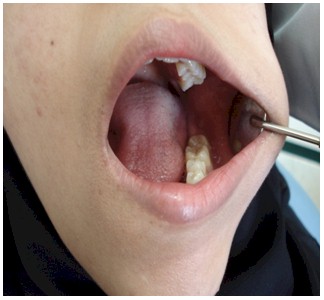
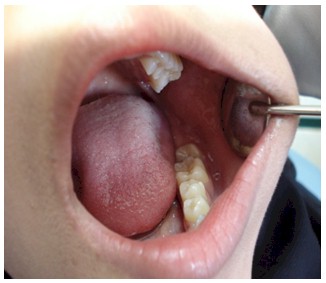
Figuras 1 y 2: segundo molar parcialmente impactado en una posición mesio-angular.
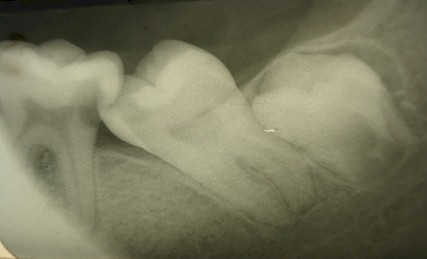
Figura 3
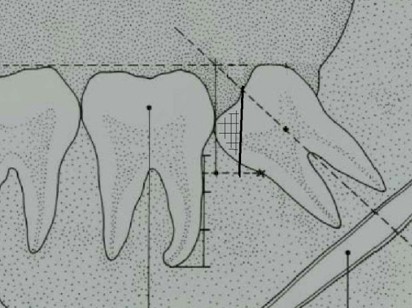
Figura 4
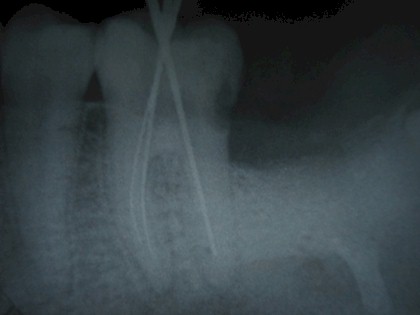
Figura 5
Bibliografía:
1. Garmendia Felipe, AM; Gonzalez Longoria, R; Clausell Ruiz, M; Bastarrechea, M; Correa Mozo, B. Retención dentaria. Rev Cubana Ortod 2000;15 (2):82-5.
2. Laskin DM. Cirugía bucal y maxilofacial, Buenos Aires: Editorial Médica Panamericana; 1988 pp 356-8.
3. Carl W, Golfarb G. Impacted teech: prophylactic extractions or not. My State Dent 1998;61(1):32-5.
4. Daley TD. The small dentigerouss cyst. Oral Surg Oral Med Oral Pathol 1998;79(1): 77-81.
5. Bernal Gómez AP, Archila Celis DL, Dorado Villamil. MF. Terceros molares incluidos. Epidemiología y contexto sistémico. Rev Fed Ondontol Colombia 2003;(206):17-25.
6. Richardson M. Impactod Third mdars. Br. Dent J 1998; 178 (9): 325.
7. Shafer WG; Heine MK; Leroy BM; Tomich ChE. Tratado de patología bucal. México: Nueva Editorial Interamericana; 2000. Sección I. p. 66-70.
8. Orellana A, Salazar E. Evaluación clínica de la terapia con Dexametazona e Ibuprofeno en la cirugía de los terceros molares retenidos. Acta Odontológica Venezolana. Vol 45, No 1,2007.
9. Donado M. Cirugía bucal- Patología y técnica. 2° Ed. Edit Masson 2001, Barcelona Esp.
10. Guías Prácticas de Estomatología. Colectivo de autores. La Habana: Ciencias Médicas; 2003. p. 430-38.
11. Cecil A, Yeman OD. Incisivo central superior retenido. Resolución quirúrgica y ortodóncica. Rev Soc Odontol La Plata 2003; 16(32):21-6.
12. Litonjua LS. Pathologic changes as societed with the angulation of impacted mandibular third molars. J Philip Dent Assoc 1997; 49 (1):14-9.
13. Knutsson K. Mandibular third molars as mediated by three cues. Dentist’s treatment decsions on asymptomatic molars, compared with molars associated with pathologic conditions. Acta Odontol Scand 1997, 55 (6): 372-7.
14. Morán López, E; Cruz Paulin Yulien. Pericoronaritis. Criterios actuales. Revisión bibliográfica. Rev Cubana Estomatol v.38 n.3 Ciudad de La Habana sep.-dic. 2001.
15. Venta I,Turtola L. Long – term evaluation of estimates of need for third molar removal. J. Oral Maxillofac Surg 2000; 58 (3): 288-91.
16. García Calderón M, Torres Lagares D, González Martín M, Gutiérrez Pérez JL. Cirugía de rescate (reubicación quirúrgica) en segundos molares inferiores impactados. Med. oral patol. oral cir. bucal (Ed.impr.) vol.10 no.5 Valencia Nov.-Dec. 2005
17. Seward GR. Surgical removal of third molars. Each case needs careful thought. BMJ 1998;309 (6964):1302.
18. Grover PS, Norton L. The incidence of unerupted permanent teeth and related clinical cases. Oral Surg Oral Med Oral Path. 1985; 59:420–425.
19. Mead S. Incidence of impacted teeth. Int J Orthod. 1930; 16:885–890.
20. Majourau A, Norton LA. Uprighting impacted second molars with segmented springs. Am J Orthod Dentofacial Orthop. 1995; 107:235–238.
21. Kokich VG, Mathews DP. Surgical and orthodontic management of impacted teeth. Dent Clin North Am. 1993; 37:198–201.
22. Sawicka M; Racka-Pilszak B; Rosnowska-Mazurkiewicz A. Uprighting Partially Impacted Permanent Second Molars. The Angle Orthodontist: Vol. 77, No. 1, pp. 148–154.
23. McAboy CP, Grumet JT, Siegel EB, Iacopino AM. Surgical uprighting and repositioning of severely impacted mandibular second molars. J Am Dent Assoc. 2003; 134:1459–1462.